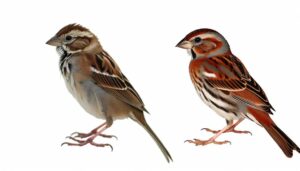5 Stunning Photos of Fox Sparrows with Creative Commons Licensing
Fox Sparrows, renowned for their diverse song repertoire and adaptability across varied habitats, have been intricately documented under the Creative Commons. This world-wide, open-source platform enables collaborative research, sharing of insights, and facilitates communication among scientists globally.
By utilizing this network, researchers have greatly enhanced the collective knowledge pool about Fox Sparrows' unique subspecies diversity, intricate vocal behavior, and their distinct ecological roles. Exploring further grants an innovative glimpse into the intricate dynamics of avian adaptability, habitat preferences, and the influential role of geographic variations on their evolutionary journey.

Key Takeaways
- Creative Commons enables free access to fox sparrow images and resources.
- A variety of fox sparrow images are available under Creative Commons licenses.
- Creative Commons resources aid in studying the diverse subspecies of fox sparrows.
- Fox sparrow songs can be found under Creative Commons licenses for research purposes.
- Open-source data on fox sparrows, accessible via Creative Commons, facilitates global research collaboration.
Understanding the Fox Sparrow
One might find it fascinating to learn that the Fox Sparrow, a distinctive species in the world of ornithology, exhibits a remarkable diversity in plumage, song, and habitat preferences.
This bird, found mainly in North America, is known for its varied subspecies, each with its unique adaptations, making it a captivating study for birdwatchers and ornithologists alike.
Notably, Fox Sparrows aren't restricted to a single type of environment. They've adapted to a range of habitats, from dense forests to scrublands.
Additionally, their songs aren't uniform, displaying a wide repertoire that aids them in communication and mating.
It's evident that the Fox Sparrow's adaptability and variation make it a standout species, truly embodying nature's complex and diverse canvas.
Key Characteristics of Fox Sparrows
The Fox Sparrow, a robust songbird, exhibits a range of distinct features that set it apart from its avian peers. Its unique characteristics, such as its size, color variations, and robust bill, are integral to its survival and adaptation in diverse habitats.
An analysis of the Fox Sparrow's behavior further reveals intricate patterns and specific traits, providing valuable insights into its lifestyle and ecological role.
Fox Sparrows: Unique Features
Boasting an array of distinctive features, Fox Sparrows exhibit a unique blend of colors, patterns, and physical attributes that set them apart in the avian world.
Their robust and thick-set body structure, coupled with a large bill, is a clear distinguishing feature.
The bird's plumage is an artistic blend of gray, brown, and red hues, often with heavy streaks on the underparts. An intricate pattern of spots and stripes adorns their chest and flanks, enhancing their aesthetic appeal.
Their wings, typically bright and rufous, have a distinctive set of white wing bars.
Significantly, their large, rounded tail often displays a reddish hue, a trait that has contributed to their name.
These physical attributes collectively define the unique morphology of Fox Sparrows, endearing them to bird enthusiasts.
Understanding Fox Sparrows Behavior
While the unique physical traits of Fox Sparrows captivate bird enthusiasts, it's their behavioral characteristics that truly set them apart in the avian kingdom. Especially, these birds are ground foragers, using a distinctive double-scratch method to uncover food, a behavior not common among their counterparts.
They're also partial migrants, with some populations migrating long distances while others remain stationary, an aspect that has intrigued scientists. Marked by a rich, melodious song, their vocal behavior is complex and varies regionally, hinting at a sophisticated communication system.
Additionally, their mating systems are largely monogamous, showcasing a certain level of social organization. Understanding the behavior of Fox Sparrows provides a fascinating glimpse into their ecological roles and survival strategies, adding to their allure.
Fox Sparrow Subspecies Diversity
The Fox Sparrow, a well-known passerine bird, exhibits a remarkable subspecies diversity, exhibiting significant geographic variation across its extensive range.
This diversity, intricate as it is, necessitates a thorough examination to identify and understand the distinctions among the different subspecies.
Through this analytical approach, not only can we classify the subspecies more accurately, but we can also explore the possible factors contributing to their spectacular diversity.
Understanding Fox Sparrow Subspecies
Remarkably, four distinct subspecies of the Fox Sparrow exist, each showcasing unique traits and adaptations that reflect the diverse environments they inhabit.
- The 'red' subspecies, known for its rufous color and bold streaking, inhabits the Pacific coastal region.
- The 'sooty' subspecies, residing in the northern Pacific coast, exhibits dark, uniform plumage.
- The 'slate-colored' subspecies, native to the Rocky Mountains, is identified by its greyish-brown feathering.
These subspecies exemplify the concept of divergent evolution, the process by which different species evolve different traits due to differing environmental demands.
Understanding these subspecies can provide keen insights into this process and the adaptability of avian species in general.
Geographic Variation in Subspecies
In studying these diverse Fox Sparrow subspecies, it's clear that geographic variation plays an instrumental role in their evolutionary adaptations. Populations of this species are spread across different habitats, each with unique environmental pressures. Therefore, each subspecies exhibits distinct morphological features and behaviors, tailored to their respective locales.
For instance, the 'Sooty' Fox Sparrow, dwelling in Pacific coastal regions, sports darker plumage than its 'Red' counterpart found in the arid, interior regions. This color divergence is likely a result of selective pressures, favoring camouflage suited to each environment.
Similarly, variations in song patterns across subspecies may reflect differing social and ecological influences. These examples underscore the profound impact of geographical variation on the diversification of Fox Sparrow subspecies.
The Unique Songs of Fox Sparrows
With a repertoire that varies across regions, fox sparrows exhibit a unique ability to create intricate and melodious songs. Their vocalizations aren't only enchanting but also provide insight into their behavioral ecology.
Song Complexity:
Fox sparrows can produce a wide range of notes and trills. Each individual's song combines a variety of elements in a distinct sequence, reflecting a high level of song intricacy.
Regional Variation:
Different populations have unique song structures, demonstrating regional dialects. This variation implies that song learning in fox sparrows is culturally transmitted, an intriguing aspect of avian behavior.
Function:
Their songs play a vital role in territory defense and mate attraction, indicating the practical function of these vocal displays. The complexity and diversity of fox sparrow songs underscore their importance in social interactions.
Creative Commons and Birdwatching
Birdwatchers often rely on Creative Commons to access and share high-resolution images and audio recordings of birds like the fox sparrow, fostering an open and collaborative environment for birding enthusiasts worldwide. This democratizes knowledge, allowing users to contribute, compare, and contrast findings. It also enhances the birdwatching experience by providing reliable identification resources.
The Creative Commons model, with its emphasis on open source sharing, offers a profound shift from traditional, restrictive copyright models. It encourages the creation of a global, virtual birding community where sharing and collaboration are the norm. As a result, birdwatchers are able to access a richer, more diverse set of resources, which ultimately improves their ability to discern between different bird species, including the fox sparrow.
Impacts of Creative Commons on Fox Sparrow Research
Turning our gaze to the specific case of the fox sparrow, the influence of Creative Commons has greatly boosted research activities around this songbird. The open access to high-quality images, audio, and videos of the fox sparrow has empowered researchers to conduct more detailed studies, irrespective of their geographical location.
Three main impacts are seen:
- Improved Observation: Researchers can now study the bird's behavior, habitat, and physical attributes without the constraints of time and space.
- Enhanced Collaboration: The open-source platform fosters global collaboration, enabling scientists to share insights and findings.
- New Data Generation: It's easier to compile extensive datasets, as individuals worldwide contribute to the collective knowledge pool, increasing the pace and accuracy of research.
Conclusion
The Fox Sparrow, a symphony in feathers, has been demystified through the lens of Creative Commons. This platform has opened a new frontier in birdwatching, allowing enthusiasts to share information, and magnifying our understanding of this bird's subspecies diversity and unique songs.
It's as if Creative Commons has given us wings to fly alongside the Fox Sparrow, contributing to a collaborative, in-depth exploration of its existence.






